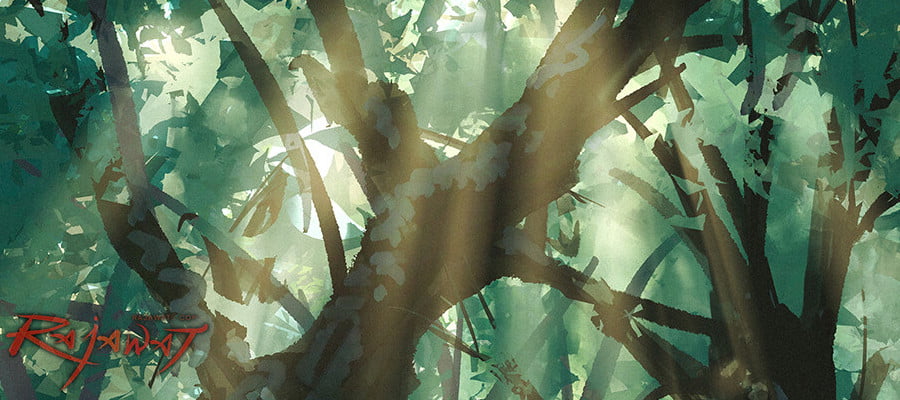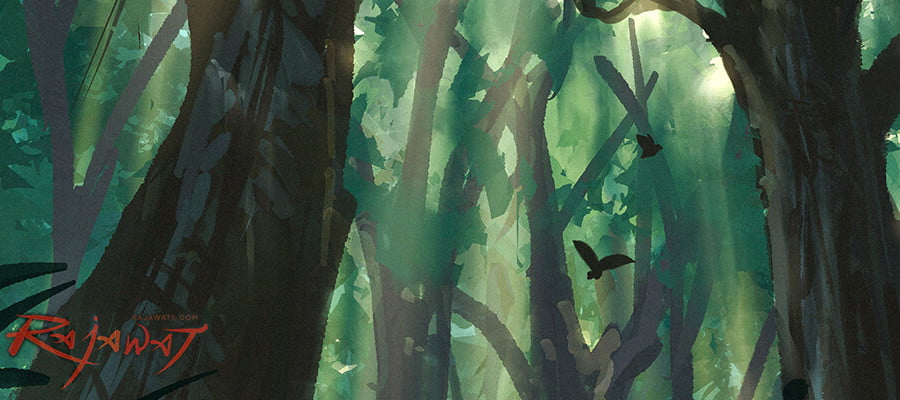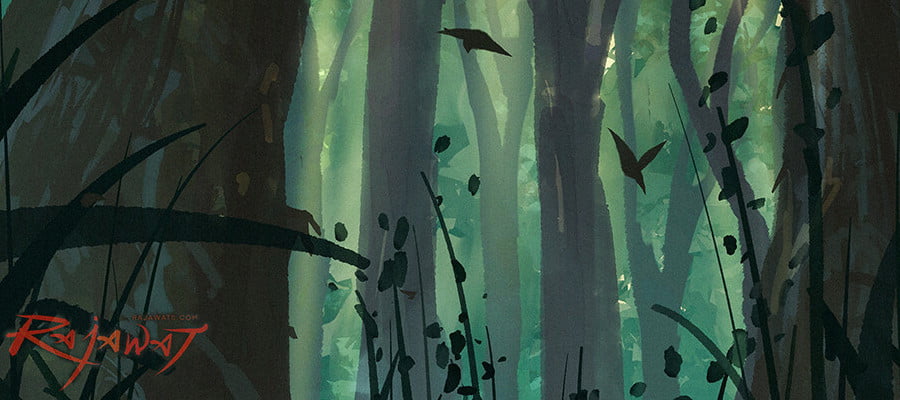North of Dal Raeda, the first landmark most obviously seen is the vast, sprawling city of Eresh, the centre and capital of the Eresh Protectorates. The heart of the highway system that crisscrosses the continent of Bidestra, it serves as a gateway towards the dragon ruins of Amenti in the west and the dread realms of mist to the east. No highway leads directly north though –
For north of Eresh lies the forest of Corrindale.
The vast, spreading, deep and uncharted woods of Corrindale, reaching far enough north to encircle ancient mountain cities, to taste the snowy skies and paying host to its own mysterious community of druids and kobolds, host to cities of Orc and Elf and uh
and uh
stuff.
There’s lots of stuff in that there Corrindale forest. And it’s uh
It’s real big.
Right like just the top part of that map?
Yeah it’s all Corrindale Forest.

Uh yeah you may have noticed me petering out there a bit.
I’ve been doing a lot of rereading my old material, finding old D&D stuff that I like and trying to breathe a more complex life into this setting. This is because I find it fun and hey it’s something that you seem to want to read (and I am so very grateful for that). As with looking at names, like I did last time, I need to look at Corrindale Forest and ask myself what it’s there for.
What’s the defining characteristic of it.
What’s it like?
Well, it’s one single homogenous forest zone that reaches across a spread of area that’s at least the size of Russia and has inside it literally no specific landmarks and no clear idea of who lives there.
It’s uh, it’s not fleshed out?
What I’m doing here, when I call it the Corrindale Forest is effectively grabbing a chunk of map and using the fill bucket tool. The forest I had laid out as ‘Corrindale Forest’ was so big and spread across so many spaces, that the idea that it was homogenous asked more questions. Forests respond to their environment, they grow on mountains and into valleys and they change the weather and they protect rivers and they can’t be particularly homogenous as they get over a particular size. When a forest is big enough it starts developing its own stuff.
What’s extra frustrating and weird is that I kinda already knew this because down south in Dal Raeda’s province of Glotharen, it’s also defined by ‘a big forest.’ It’s much smaller, but it’s still so big that you could find a timeless tree that’s got a haunted magic library in it that’s the centre of a doctrinal war between druids who insist they don’t have a doctrinal war.
I don’t really have maps for Cobrin’Seil.
I did, once – I had drawn it and put it in the front of my player handouts, loose plastic folder sleeves that were full of printed lore, original prestige classes and descriptions of locations that I know they largely didn’t get or care about that much. It’s not that they didn’t care, it was just misdirected effort. I cared a lot about creating the illusion of legitimacy but in the process I kind of left a lot of my world as ‘blank’.

I get defensive about worldbuilding ‘laziness,’ because it’s often not laziness as much as a lack of inspiration or a paralysis of choice or a helplessness of ignorance. I don’t know how mountains should look, I don’t know how rivers should work. I can look at my own real world and point at it and the thing is, because I learned about the world around me starting in Australia, things like ‘mountain ranges’ happen to other people. And when you start to commit to things you start to make mistakes, and those mistakes can be pointed out by players and then I suddenly feel like an idiot, even though nobody is trying to make me feel like an idiot.
There are some geographical tropes that people make fun of because they’re ‘overdone’ like having a polar area that’s cold and hard to live in that gets called things like ‘the wastes’ or ‘the dread north.’ I don’t have that any more but I did, then it got made fun of and I quietly stopped using it for anything and now it’s faded away from the map like it got The Snap.
This isn’t a solution, by the way. This is an examination of the problem. It’s spitballing, and it’s trying to list what the problems are. It’s not just ‘Corrindale is boring,’ it’s that Corrindale is vast and empty and underdeveloped. It can be seen as a place to put down things that I do think are really cool. Corrindale, if it is a forest the size of Russia, needs to have something there. It’s an interesting thing to consider that for all the stories I’ve set in this world, a bunch of it is empty. It is an incomplete place… and I can put cool stuff all over the place, I’ve just never bothered to.
What can go there?
First, there are the high-up trees of the Wu Kan, a heritage of Monkey-Magic inspired monkey people. These are a longstanding part of the setting, a really charming group of reckless people who get by on luck. They make great instigators and their communities are small, prosocial and go up in high trees. Thanks to their association with the aesthetic of well, Monkey Magic, they probably are going to be in a region that can be used for that set of tropes – which means that part of this forest is going to reach to a western Asia style region.
When the forest is so big and people can live on multiple levels of it, it may be a thing that whole cultures can occupy similar spaces and not even realise their proximity. I kind of like the phrase the sea of leaves, the idea that there’s this space where (say) orcish tribes and wu-kan people live in completely different levels of the canopy and don’t realise they’re there. After all, I’ve written about how Orcs in Cobrin’Seil live differently.
There’s obviously going to be cities within the forest – towns at least. They probably arent’ all Eresh protectorate towns, which means there’s probably some kind of nation there, probably a few. I think, unlike nations in broader spaces that see their borders as being defined by other nations, though, the nations within Corrindale look at themselves as bubbles of ‘a nation’ defined by some natural region or easily defined perimeter.
Mountains. There will probably be some kind of mountain or range of them in the space. I mean it’s just a matter of space. You can’t have these huge biomes where there’s no variance. I’m pretty sure that someone would be able to explain that. Lakes too. There’s also got to be a range of climates – I mean just looking at North America, the forests in the northern part of the continent are snowy and have wolverines and the forests at the southern part also… are snowy and have wolverines, I think, but that’s an altitude problem.
Point is they’re not just a drape.
Also, in 4e, I have the cultures of the ‘elf‘ people. In Cobrin’Seil, elves are basically a chunk of the Feywild that tried to act like people because it was curious, and that chunk then splintered into different groups over time – the Eladrin (Elves that are still fairy-ish), and the Elves (Elves that are more made-of-meat), and the Shadar-Kai (Elves that tied themselves to the Shadowfell). Corrindale is a great place to put a nation of the elves (the made of meat ones), and also cities of the Eladrin and Shadar-Kai (which can be hidden away in impossible fey-portal nonsense). I’ll also consider Fox’s Gruuwar, Firbolg and Pookah here.
I think a big part of this is ‘why is the forest here, unchanged over time,’ and while it could just be ‘because it’s really bloody dangerous to try and change it,’ I like it better to think in terms of choices people make. You don’t just randomly get killed by a forest, you get killed by things in a forest (or getting lost). If those things in the forest have some agency, that makes things more interesting.
Oh and of course, there have to be communities of the Dio Baragh.

I have in the recent days sat down to try and reconstruct a map of the world with a vision of the different nations in it that just are developed enough that I can tell you more about the nation as a place than I can about it as a place to reference Quest For Glory setpieces, and it’s not an impressive list. In fact, to be totally honest, I think that right now, if you asked me to list the countries in the world that have more meaningful detail than ‘name,’ it’d be a list of three, and that’s pushing it.
That’s a problem but it’s also kind of freeing. I can start work on the map anew, knowing what I do now.
I can make it better.
Cobrin’Seil is a world in part invented by a teenage boy who liked this D&D thing he was checking out and in part made out of ripping off random things I like. The ripping off is not going to stop just because I’m older now, don’t get that twisted. What I needed, originally, was all based on the Quest For Glory series; I needed a Spielburg (a European-ish forest barony), a Shapier and Rasier (a Persian-ish pair of city states in a desert), a Tarna (though I kinda skipped this one, even though I did the world building here), and a Mordavia (where I also jammed a bunch of ideas from Ravenloft and thankfully, not the super obvious racist ones).
My central starting point, the Kingdom of Kyngdom, now Dal Raeda, is kind of what happens when you ask an Australian boy to invent something like Europe out of first principles. It’s a single nation, divided up by a river network, where each state is basically large enough to be a kingdom unto itself, and the tension it creates when most of them are functionally independent but politically consider themselves united. That happened, because I fixed it and I really like what the fix brought with it. That’s where our Spielburg is; it’s a place where lots of small baronies and knights and lords can claim responsibility and authority in an area but where those groups are just as likely ignored by their communities because you can’t run an army with like, twelve dudes. The Persian-inspired places are over on the Arnean continent, along with my Tarna, and the Mordavia became the dreadfully named Kryphaneos (I need to fix that).
But y’know how you fix a world?
One problem at a time.
The lovely art of the forest in this article is by Surendra Rajawat.

1 Trackback